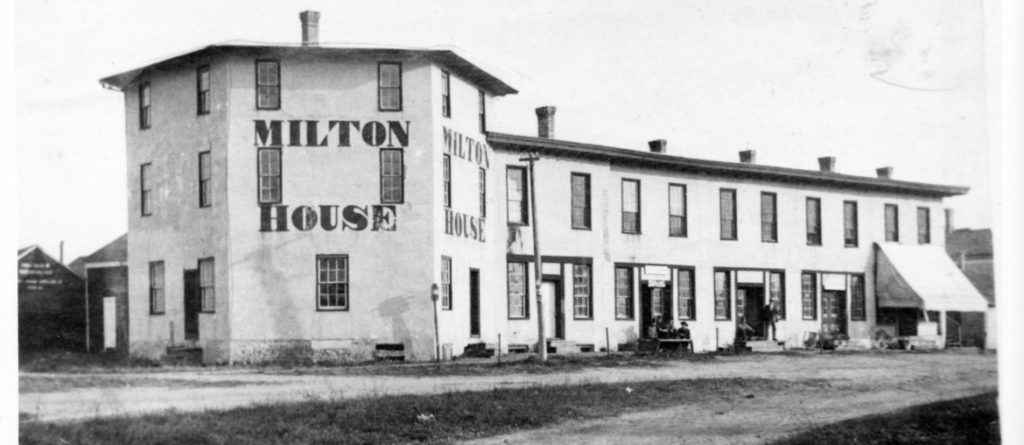Exact numbers will never be known, but archival records indicate that between 1842 and 1861 more than 100 escaped slaves appear to have found freedom by way of Wisconsin. According to the Wisconsin Historical Society, even the passing of the Fugitive Slave Act in 1850 — which subjected anyone helping an escaped slave to stiff penalties — didn’t stop Wisconsin abolitionists.
MILTON HOUSE
As slaves and those who aided them — like Joseph Goodrich — went to great lengths to hide their efforts, exact details of exactly how and where the underground railroad operated in Wisconsin are still not entirely clear. But one documented site still with us today, and open for public tours, is Milton House.
“There are a lot of rumored properties around the state, with claims to be tied to the underground railroad, and quite a few in Burlington, Wis. but most haven’t been verified by the national network to freedom,” says Cori Olson, executive director of Milton House. “As far as I know, we’re the only remaining structure [in Wisconsin] verified and open for tours.”
At Milton House, in the rural community of Milton, near Janesville, visitors experience a true underground passage. built by underground railroad conductor and Wisconsin pioneer Joseph Goodrich, who founded the town of Milton, Milton House is today a national historic landmark. Goodrich and other pioneer Milton families were members of the Seventh Day Baptist Church, and had ventured west to Wisconsin from upstate New York in 1838. Ardent abolitionists, they became active locally in the Underground Railroad.
A bustling inn in its day, runaway slaves entered a log cabin about 10 feet behind what was then the Milton House Inn via a trap door. Originally only three-feet high, the tunnel was widened in 1954 and lined with stones to more safely accommodate tour groups. In the mid-1800s, though, this door to freedom looked no different than the door to any root cellar standard for the era.
Once past the trap door, runaway slaves navigated the 45-foot-long tunnel until they reached the inn’s basement. It was here in the basement that the Goodrich family provided those seeking freedom with shelter and food. For all this to go undetected was indeed remarkable. Located on what was then territorial road — and today Wisconsin Highway 26 — the Chicago & Northwestern Railroad crosses here meant Milton and Milton House Inn were busy, thriving places. At its peak, 27 stagecoaches and 36 trains stopped daily at this rural hamlet.
Though Goodrich could not make known Milton House’s status as a stop on the Underground Railroad, he did make known his staunch opposition to slavery. In 1852, and under his leadership, the Seventh Day Baptist Church’s general conference adopted this resolution:
“Resolved, that we enter our solemn protest against the system of American slavery, as a sin against God, and a libel upon our national declaration, that all men are created equal, that we regard the fugitive slave law as an atrocious violation of the rights of humanity … and that to aid in its execution would be treason to Jesus Christ.”
The Milton House remained in the Goodrich family until 1948, when members donated it to the Milton Historical Society. Five years of restoration work ensued and in 1953, Milton House was opened as a museum — a secret no more. An addition in 2006 allowed the museum to be open year-round.
For information on hours, admission and more, go to miltonhouse.org.
RACINE COUNTY
Like Milton, Racine County also had a strong abolitionist community. The corridor between the cities of Racine and Burlington is mentioned frequently in oral history related to the Underground Railroad. The Racine Heritage Museum explores that history in detail with its “this train Is bound for glory: Racine County’s Underground Railroad” exhibit.
Here, stories of secret hiding places, narrow escapes and a community spurred to action are brought to life with artifacts, images and an interactive Underground Railroad role-playing activity.
The First Presbyterian Church in Racine is also available for tours. The church proudly proclaims to be Racine’s longest-standing congregation. Here, runaway slaves are believed to have hidden in crawl spaces and secret passages — possibly on Sunday mornings while church members were in the sanctuary for worship. While firm evidence to support its stop on the Underground Railroad is lacking, the oral history is strong enough that the church offers free tours to groups.
Tours are not scheduled on a regular basis and must be requested at least two weeks in advance. Equal parts architectural — with access to possible hiding spaces — and art, the tour also includes an exhibit of quilts, highlighting African-Americans’ struggle for freedom.
firstpresracine.org
Also in Racine is the Joshua Glover Commemorative Marker. The marker is located at Racine’s Monument Square, at the intersection of Main Street and 6th Street. It tells Wisconsin’s moving and most famous story in the battle against slavery. On March 30, 1854, a large crowd assembled in the very spot to protest the capture of Joshua Glover, a Missouri slave.
Abolitionists across southeastern Wisconsin surrounded the Milwaukee jail housing Glover, broke down its doors and ultimately were able to help him make his way to Canada.
The jail is long gone, but a marker commemorating Glover’s forcible release is located at Cathedral Square Park, at the intersection of East Kilbourn Avenue and North Jackson Street in Milwaukee.
This article originally appeared in the 2015 spring/summer issue of Experience Wisconsin magazine. The contents of this article were checked for accuracy when it was published; however, it’s possible some of the information has changed. We recommend you call first if you have specific questions for the destinations, attractions or restaurants mentioned in this article.
No portion of this article or magazine may be reproduced without prior written permission by the publisher.

